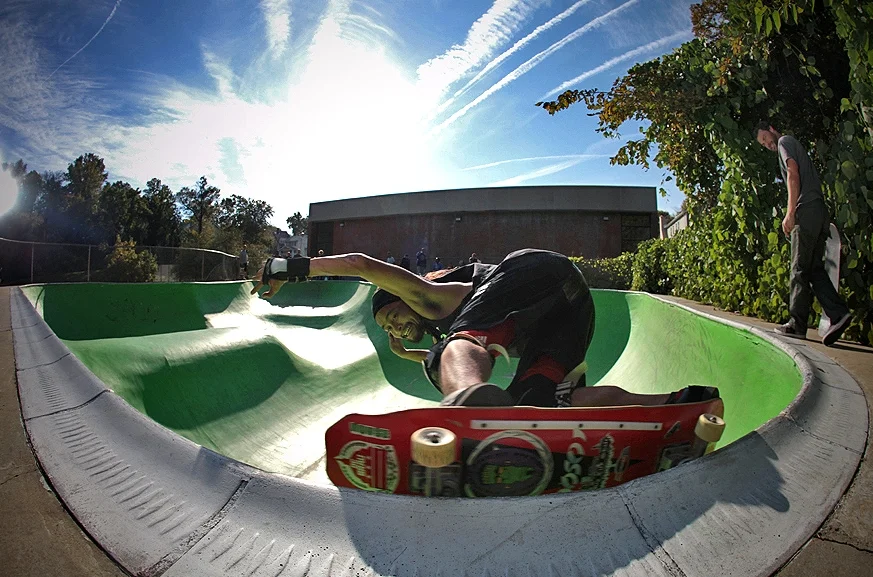The Birth of Finding a Line
When I was a kid growing up outside Richmond, Virginia, we would come into the city at night and skateboard. When we did, the streets were no longer streets, sidewalks were no longer sidewalks, and curbs were no longer curbs. All became a playground for riding, learning, experimenting and failing. There were no rules, points, or winners. We were just making it up as we went along. It was this simple act at the core of skateboarding - finding a line through the world around you - that taught me the concept of reimagining public spaces and gave the project its name. Today, Finding a Line is an ongoing, community sourced art project that takes the improvisational act at the core of skateboarding - finding a line through physical space - and applies it to the process of transforming community spaces. Welcome.
Photo: The Late Great Andy Kessler by Ivory Serra
Green Skate Lab
In the spring of 2003, a group of friends and I decided to take the old philosophy of reimagining space and make it tangible. So we came together to reclaim an underused recreational space and turn it into the country's first green skate park. We reused old tires and space no one wanted to create something useable. Before it was over, it had become a collaborative design + build project emphasizing recycling, physics, and environmental science using professional, student, and community labor. I didn't know it yet, but it was the beginning of Finding A Line.
video credit: Joe Hancher
photo credit: John Falls
Kennedy Center
Fifteen years and countless hours of mud, concrete, and bloody knuckles later...
Opening Night
This latest iteration focused on the intersection of the improvisational art forms of jazz and skateboarding. Hosted on the iconic grounds of the Kennedy Center, the nine day festival brought together members of creative communities as varied as music, art & design, fashion, filmmaking, photography and skateboarding to create something entirely new.
Fight Club / Chaos is Beautiful
Before the Kennedy Center Project was even an idea, there was Fight Club. I could say that at Fight Club, I was a principal partner in a private recreational and creative space for skateboarding, arts, music, documentation and construction. But really, I was just holding on for dear life as it exploded into life around me. What began as a simple attempt to find someplace warm and dry to skate became a crucible for explosive and uncontrollable cross-pollination of skateboarding, art, music, and social interaction where literally anything could happen. After two years of increasing popularity and a wildly creative (and destructive) party, we had to go underground in order to survive. So we organized a media campaign to proclaim the “death” of FCDC.
Bridge Spot
The first official iteration of the Finding a Line projecttook place under a bridge in DC as part of the temporary public art project, 5×5. When we began, the space served as a barrier between two wildly different neighborhoods. I collaborated with Workingman Collective, John Falls, other artists, activists, skaters, and the community to activate the space and create a point of connection between the neighborhoods. We called it Finding a Line, and it launched in March of 2012. Afterward, the space took on a life of its own, eventually becoming home to everything from live music, art and dance, to a one-time only motorcycle jump over a bathtub full of ramen. http://benashworth.blogspot.com
About 5x5
5x5 is twenty-five groundbreaking temporary public art installations that were installed concurrently throughout the District of Columbia. 5x5 coincides with the Centennial National Cherry Blossom Festival.
Icons
Jason Moran and the Bandwagon, H.R. of Bad Brains, Chuck Treece of McRad, and Ron Allen - all onstage and finding a line together.
Mind = blown.
Photo: Anthony Smallwood
Video: Woodward Media and The Kennedy Center
Sessions / Blind Whino
With Finding a Line, sessions are our process for bringing new ideas into form with the public. What you're looking at is a build session at Blind Whino DC to set up a section of the evolving stage and do a trial run within the community. DC artists brought their own unique histories to the table and together we sat down and booked bands, dj's and muralists; shot photos and videos; laughed, played music, and skated.
Rose Jaffe
Rose Jaffe is just one of the many artists who embraced the spirit of improvisation and came and collaborated at the Kennedy Center.
David Alan Harvey
Not everything that happened at Fight Club was out of control. We also managed to serve as a dynamic venue for art openings, live music, dance performances, and exhibitions - including the FotoWeek DC Fixation project featuring artists like David Alan Harvey.
Sessions / SPACYCLOUD
As a part of Finding A Line at the Kennedy Center, DC based Skate Girls Tribe brought the all-girl thunder...
Sessions / ArtChangeUS Kennedy Center National Conversations DC
Can the arts play a role in the countering, instead of spurring gentrification? How do an architect, a skateboard activist and a muralist work to support thriving communities? With this session, we broadcast a national conversation centered on urbanism and placekeeping.
Sessions / ArtChangeUS National Conversation@ Finding a Line LA
Sessions / No Comply | Documentary Short Film by Raghav | Kuchhmachli
No Comply is an animated/live action documentary co-directed by Raghav Arumugam and Jagriti Khirwar. This spontaneous session features Skaters like Jason "Weeman" Acuna, Laban Pheidias, Kristian Svitak, Ben Ashworth and Garth Ross as they discuss and celebrate what makes skateboarding culture.
Finding A Line at Union Market: Community-based skatepark & art project
after premiering at the Kennedy Center in 2015, the Finding A Line project migrated to the Union Market area of DC in collaboration with Gallaudet University and George Mason University. Since then, the project hosts weekly sessions that combine skating, music, and media as a socially-engaged platform for a variety of actions and research.














